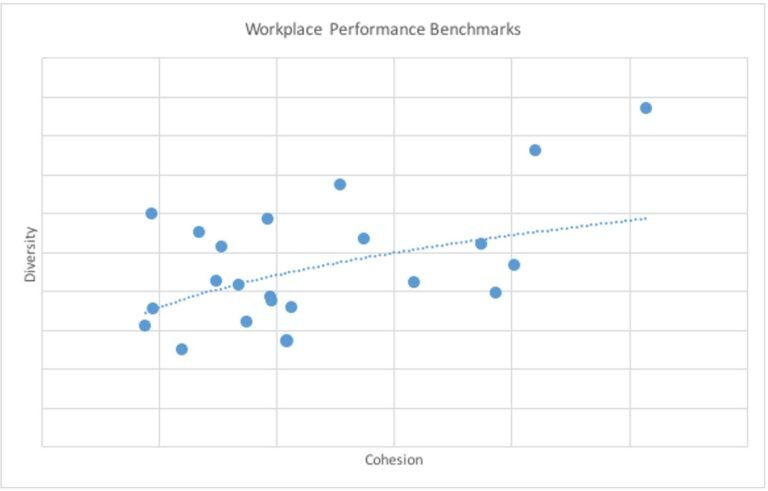How Enterprise Social Systems Can Help Build Diversity & Inclusion
We have no formal affiliation with the MIT (Massachusetts Institute of Technology) yet we are regularly surprised by how often our research paths cross. Sometimes our applied research findings reinforce theories first posited by a MIT academic. At other times we have achieved parallel findings; our insights drawn from our own social networking data analyses and MIT’s experimental discoveries. The first time we crossed paths was when we found a client's email traffic travelled between senders and recipients located, on average, only six metres apart. We were somewhat surprised and excited that our finding was predicted by renowned MIT Professor Tom Allen. His ‘Allen Curve’ predicts how the quality of communication degrades with physical distance; and surprisingly holds up even when the communication goes digital. The second time was more of a parallel discovery. Having conducted more than 100 SNA (Social Network Analysis) projects we had come to the conclusion that the most reliable measure of group cohesiveness was the number of reciprocated relationships that are held within a group. MIT Professor Sandy Pentland came to the same conclusion from his experiments with teams using social tags designed to capture social cues from team members in real time.
Digital social channels and Diversity
Our most recent parallel insight is with respect to how digital platforms can help connect diverse employees into superior collective innovation and decision makers. Gerald C. (Jerry) Kane, the MIT Sloan Management Review guest editor for the Digital Business Initiative recently identified that digital platforms can indeed enjoy the benefits from connecting a diverse workforce; though purposeful intervention would be required. If left to its own, digital platforms will simply reinforce the formal structure and ‘group think’ behaviours. Kane also reported “that while only about 30% of employees from companies at an early stage of digital development say that their company is collaborative, more than 70% of employees from digitally mature companies do.” In summary, the research indicates that collaborative performance is tied to digital maturity. Specific advantages from digital interventions, like increased employee diversification in decision making, required purposeful interventions and cannot be left to organic self-management.
Non-digital vs Digital Channels and Diversity/Inclusion
We have conducted survey-based ONA/SNA studies for more than a decade now and collected benchmarking data using a Network Performance framework which positions an organisation’s cohesiveness against its diversity; and where maximum performance is achieved when both diversity and cohesion are maximised at the same time. The graph below identifies the diversity/cohesion scores for selected organisations, identified by their industry sector. Significantly we found that diversity and cohesion were largely trade-offs i.e. the more cohesive your organisation was, the less diverse you will be and vice versa. It also showed that different industries displayed different network performance characteristics, with engineering and management consultants proving to be more cohesive but less diverse/inclusive; and the utilities and pharmaceuticals being more diverse/inclusive, but less cohesive.
We established SWOOP in 2014 to be able to conduct ONA/SNA in real-time using digital social channels, rather than direct surveys as the source data. What became quickly apparent when we applied our performance benchmarking practice was that this trade-off between diversity and cohesion no longer existed. If anything we see something approaching the opposite i.e. organisations were able to maximise both their cohesion and diversity at the same time.
The above graph was taken from our recent benchmarking analysis of 22 Workplace by Facebook implementations. We should point out that our measure of diversity differs for our survey-based SNA/ONA (%connections that span formal lines of business) and digital social channels (number of online groups one is active in). Data availability is limiting our ability at the moment to use a common measure. We are confident though that the common essence of diversity is being captured.
Potential Implications
A key insight from our research that is reinforced by the MIT research is that digital social channels provide a unique opportunity for organisations to be more inclusive in their decision-making. Digital channels provide the opportunity for having more diverse employee participation, stretching beyond the formal lines of business. However, we also corroborate the MIT research assertions that increased inclusiveness will not happen if left to pure organic mechanisms. Without an express purpose and aligned interventions to promote inclusiveness, the digital channel traffic will tend to follow the formal lines of business; and if anything, reinforce existing business silos, rather than help break them down.
As we can see from our Workplace by Facebook benchmarking, two organisations in particular were successfully maximising both diversity and cohesion. In our profiling of these benchmarked leaders, it became apparent that these organisations did indeed display a level of maturity in their use of digital social channels, not as evident in poorer performing organisations. Both organisations had CEOs who modelled the behaviours they expected on the social channels. One of the leaders benefited from a largely millennial-aged workforce, that came with an expectation that social channels should exist to help them do their work. Maturity was not a function of ‘time in the game’, but one of transparency of purpose and inclusiveness, from the very beginning.
The good news is that fast tracking to becoming a highly inclusive and high performing organisation can be achieved, if the organisational leaders take charge by ‘working out loud’ and personally modelling the communication and collaboration behaviours that they expect from the organisation as a whole.



